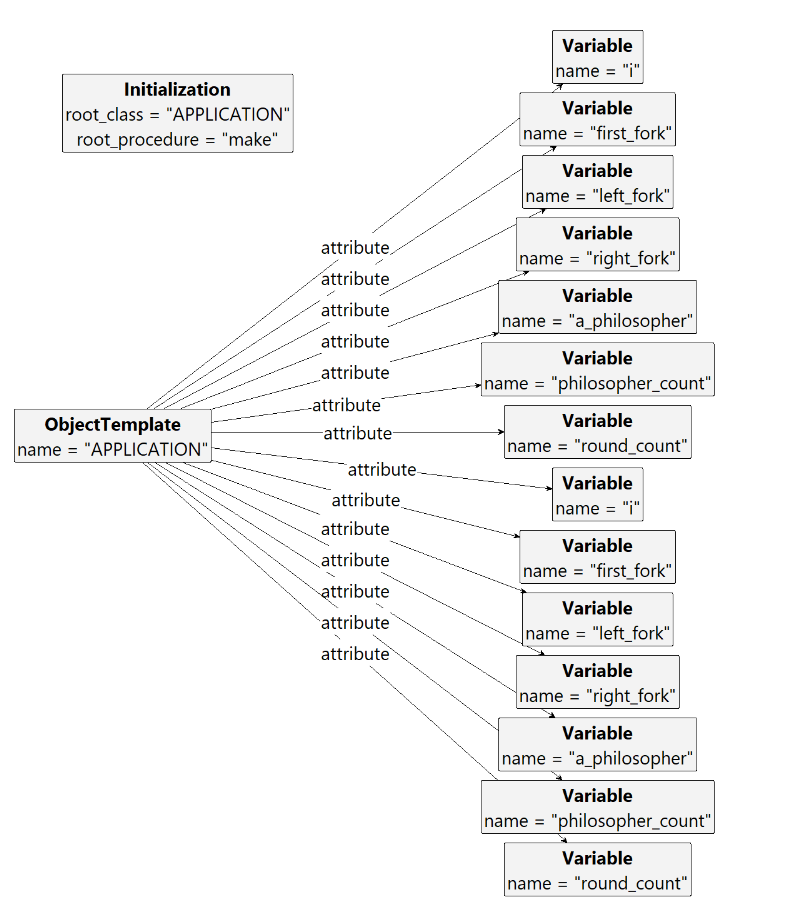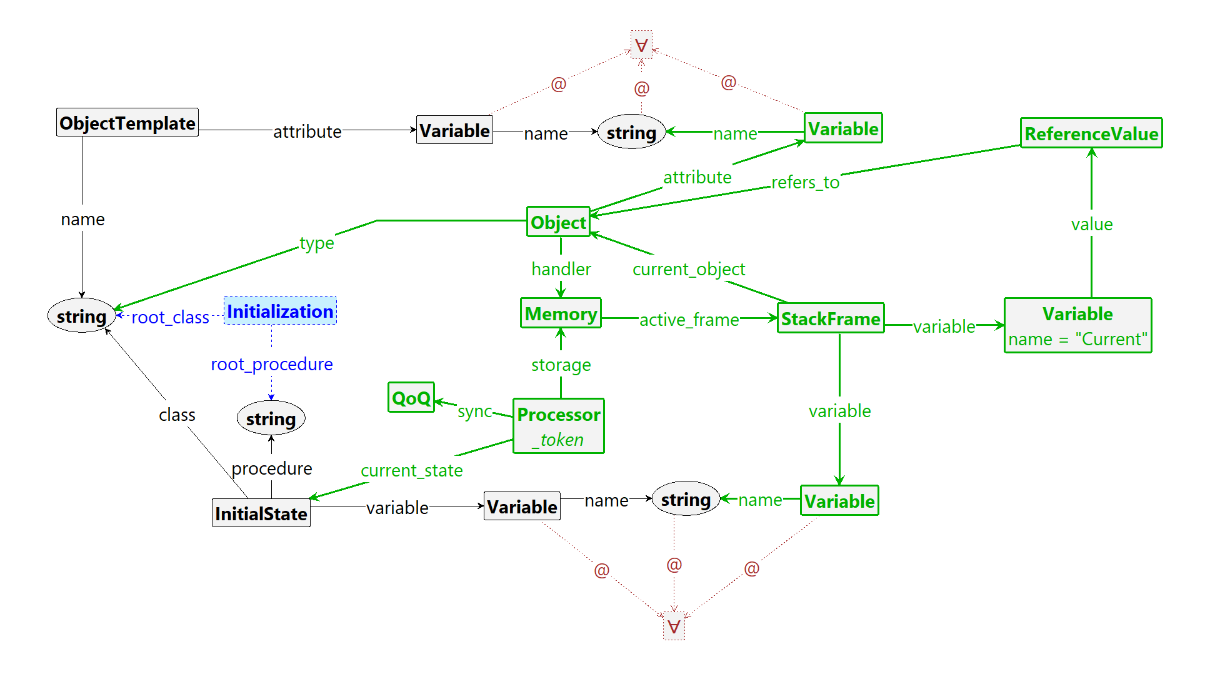Dining Philosophers Example
Throughout the paper, we use the example of the dining philosophers to illustrate the workbench and toolchain. Due to space constraints, the presentation is limited to a few select features of both. Here, we aim to cover the example in more detail by providing additional code snippets, graphs from the Scoop-GTS.
Note that some of the text here is copied verbatim from the paper, however, we will not further indicate those sections here.
SCOOP Implementation
The following SCOOP code implements the dining philosophers as presented in the paper.
The main application that initializes problem instance is implemented in the class APPLICATION:
class
APPLICATION
create
make
feature -- Initialisation
i: INTEGER
first_fork, left_fork, right_fork: separate FORK
a_philosopher: separate PHILOSOPHER
make
-- Create philosophers and forks
-- and initiate the dinner.
do
philosopher_count := 2
round_count := 1
-- Dining Philosophers with `philosopher_count' philosophers and `round_count' rounds.
from
i := 1
create first_fork.make
left_fork := first_fork
until
i > philosopher_count
loop
if i < philosopher_count then
create right_fork.make
else
right_fork := first_fork
end
create a_philosopher.make (i, left_fork, right_fork, round_count)
launch_philosopher (a_philosopher)
left_fork := right_fork
i := i + 1
end
end
feature {NONE} -- Implementation
philosopher_count: INTEGER
-- Number of philosophers.
round_count: INTEGER
-- Number of times each philosopher should eat.
launch_philosopher (philosopher: separate PHILOSOPHER)
-- Launch a_philosopher.
do
philosopher.live
end
endThe philosophers’ behaviour is implemented in the class PHILOSOPHER:
class
PHILOSOPHER
create
make
feature -- Initialisation
make (philosopher: INTEGER; left, right: separate FORK; round_count: INTEGER)
-- Initialise with ID of `philosopher', forks `left' and `right', and for `round_count' times to eat.
require
valid_id: philosopher > 0
valid_times_to_eat: round_count > 0
do
id := philosopher
left_fork := left
right_fork := right
times_to_eat := round_count
ensure
id_set: id = philosopher
left_fork_set: left_fork = left
right_fork_set: right_fork = right
times_to_eat_set: times_to_eat = round_count
end
feature -- Access
id: INTEGER
-- Philosopher's id.
feature -- Measurement
times_to_eat: INTEGER
-- How many times does it remain for the philosopher to eat?
feature -- Basic operations
eat (left, right: separate FORK)
-- Eat, having acquired `left' and `right' forks.
do
-- Eating takes place.
ensure
has_eaten: true
end
live
do
from
until
times_to_eat < 1
loop
-- Philosopher `Current.id' waiting for forks.
eat (left_fork, right_fork)
--bad_eat
-- Philosopher `Current.id' has eaten.
times_to_eat := times_to_eat - 1
end
end
bad_eat
-- Eat, by first picking up `left_fork' (and picking up `right_fork'
-- in the `pickup_left' call.
do
pickup_left (left_fork)
end
pickup_left (left: separate FORK)
-- After having picked up `left', proceed to pick up `right_fork'.
do
pickup_right (right_fork)
end
pickup_right (right: separate FORK)
-- Both forks have been acquired at this point.
do
-- eating takes place
end
feature {NONE} -- Access
left_fork: separate FORK
-- Left fork used for eating.
right_fork: separate FORK
-- Right fork used for eating.
invariant
valid_id: id >= 1
endFinally, the forks are represented as instances of the trivial class FORK; they do not have any logic associated, but are used as separate objects in philosopher arguments. Consequently, the SCOOP runtime will ensure that a fork can be held
by a single philosopher at a time. The implementation is as follows:
class
FORK
create
make
feature -- Initialisation
make
do
end
endA SCOOP-Graph program represenatation
In a first step, we translate the source code to start graph, which mainly consists of a collection of control-flow graphs, each representing a method in the source code. For example, the generated control-flow subgraph can be seen in the following figure.

pickup_leftIn this example, there are two State nodes (one InitialState and one FinalState node), as well as a single Command node. The ActionCommand corresponds to the source code line Current.pickup_right (right_fork); likewise, other actions such as ActionAssignment or ActionPreconditionTest correspond to the source code abstractions. With this close mapping to the source language, the control-flow-graphs remain easy to understand and intuitive even for SCOOP programmers unfamiliar with graph transformation systems.
Representing runtime state
In SCOOP-GTS, there is initally a single node indication the root procedure, i.e., the method that is executed at the beginning of program execution (unlike other languages like C, there is no convention for a program entry point; instead, any method can be selected by instructing the compiler accordingly). Together with Object Templates, i.e., graphs containing class name and attribute names, the runtime state can be initialized. The following figure shows the root configuration node and the template for the APPLICATION class.

In the QoQ semantics, the rule named rule_scoop_qoq_initialize_root is used
to initialize the runtime state representation, shown below.

Here, the rule matches the Initialization node which is then deleted upon rule application (indicated by coloring node and edges blue). By matching the root_class edge to the ObjectTemplate with the same name, the rule can create a new Object node (nodes and edges added during application are colored in green). Using a universal quantifier (∀), the rule matches all attributes connected to the template and thus we can create object-local copies. Since this rule is used in the QoQ semantics, the rule also creates the first Processor, as well as a representation of Memory state and an empty queue of queues (QoQ) node. Finally, the processor’s current state is set to the InitialState node of the root procedure.
After this setup, the system is initialized with a root object and a root processor that is about to execute the root procedure. Similar rules exist for the RQ and DSCOOP semantics.
Controlling execution through control programs
The Scoop-Gts consists of a large number of rules (in the source code, each .gpr file corresponds to one rule) in various categories like evaluation of references, cleaning up nodes and edges that are not used anymore, or moving a processor’s execution along the control flow graph. If one simply non-deterministically applies a rule that matches, one has to introduce helper nodes and edges in the graph and rules in order to force a certain execution. For example, a Scheduling node could be introduced to indicate that one of the scheduling rules (such as scoop_qoq_scheduling_action_command_remote_empty, which creates a separate request for a command action) can now be applied. Then, each scheduling rule has a Scheduling node, meaning that only if this node is present the rule can be applied, and each other rule has a negative-application condition for Scheduling, meaning that when the state graph indicates that execution is in the scheduling process, no other rule is applied.
With more and more rules, however, controlling the execution order with (negative) application conditions can be hard to track and results in the introduction of many helper
nodes and edges. Furthermore, optimizations that reduce the state space (e.g., by forcing a particular processor the execute local computations as long as possible before handing control to the next processor) are difficult to introduce.
Fortunately, Groove provides so-called control programs, which can be thought of as a set of functions (called recipes) that dictate the order in which rules are applied. A simple example (unrelated to the actual implementation) is as follows:
while (no_error) {
alap execute_action;
}
recipe execute_action() {
execute_command_local |
execute_command_separate |
...;
}Here, the main loop would execute as long as a rule no_error can be applied. In the body, we execute the recipe as long as possible (alap keyword), which in turn applies one of the stated rules nondeterministically (a | b is a nondeterministic choice).
Using control programs helps us to keep rules simple. For example, without control programs, the above rules execute_command_local and execute_command_separate would need to contain application conditions that test whether there is an error or not. With the control program, this can be avoided.
Another advantage is that control programs can be used to force certain interleavings in the state-space where exploring all possibilities is not relevant to the runtime. For example, suppose we have three garbage collection rules that leave the graph in the same state when applied as long as possible. Without a control program, we may end up exploring all different possibilities, just to arrive in the exact same state. In contrast, if we write a control program that applies the rules as long as possible in sequence (that is, alap { first; second; third; }), only a single execution trace is generated.
One major use of the above example in Scoop-Gts is that we can force processors to execute local computations (i.e., computations that do not involve data guarded by other processors) as long as possible before yielding control to the next one. This way, we considerably decrease the branching where it does not matter (in the sense that the asynchronous or distributed behaviour is influenced).
In the case of Scoop-Gts, the control programs are more complex. A simplified version is given in the paper in Listing 5; in the source code, they are stored as .gcp files, and they can be edited in the Groove UI.
Detecting a deadlock
After translating a SCOOP program to a Scoop-Gts graph and selecting the runtime, the Groove Simulator or our command-line wrapper can be used to explore the state space of the program under the selected runtime.
In order to detect discrepancies and errors, we can define rules that are periodically tested during state space exploration. For example, a rule that detects a deadlock involving two processors looks as follows.

Whenever such a rule matches during state space exploration, this means that under the given semantics, the error may occur. In this example, we then create a DeadlockError node, which is an Error node. Whenever one such node exists, the control program finishes, meaning that such a state is a final state in the generate state space. If there are no errors and execution finishes, final states are graphs where no processor is executing any method anymore, and all that remains are the processor, memory, and queue subgraphs, none of which is connected to a method control-flow graph.
Once the Groove exploration finishes, we can query the final states and inspect them. Since the graphs are saved as simple XML files, we can easily parse and look for Error nodes, such as ErrorDeadlock. If there is such a node, we report it accordingly. While currently not implemented in our tool, the closeness of a Scoop-Gts program representation and the source code, it is straightforward to map errors back to relevant locations in the source code.